Ever thought about how important internal customer service is? It’s not just about external clients; it’s about how departments and colleagues interact. Smooth internal interactions are the backbone of a productive workplace. When one team needs something from another, that’s an internal customer service moment. If these moments are clunky or frustrating, it slows everything down. That’s where an effective internal customer service survey template comes in handy, helping you pinpoint exactly where improvements are needed.
Imagine a world where every internal request is handled efficiently, where departments feel truly supported by their colleagues. Sounds good, right? Achieving this level of synergy requires understanding current pain points and celebrating what’s already working well. A well-designed survey can be your secret weapon, providing the insights you need to foster a culture of exceptional internal support.
Why an Internal Customer Service Survey Template is Your Secret Weapon
So, why go to the trouble of surveying your own team members? It might seem like an extra step, but the ripple effects of understanding internal dynamics are profound. Think of it as a health check-up for your organizational efficiency. When one department provides a service to another – be it IT support, HR assistance, or marketing collateral – those interactions directly impact overall productivity and employee satisfaction. Ignoring these internal touchpoints is like trying to drive a car with a flat tire; you might move, but it won’t be smooth or efficient.
An internal customer service survey template helps you move beyond assumptions and anecdotal evidence. It provides concrete, actionable data from the very people experiencing these interactions daily. This data can highlight bottlenecks, uncover training needs, and even reveal hidden champions who are excelling at supporting their colleagues. Without this structured feedback, issues often fester, leading to frustration, delays, and a decline in cross-functional collaboration.
Furthermore, conducting these surveys signals to your employees that their experiences matter. It shows that management is committed to creating a supportive and efficient work environment, not just for external customers but for everyone within the organization. This commitment alone can boost morale and encourage a more collaborative spirit. Employees feel heard, valued, and empowered when their feedback leads to positive changes.
Key Benefits of Utilizing an Internal Customer Service Survey Template:
- Identify Pain Points: Pinpoint specific areas where internal service is lacking, whether it’s slow response times, unclear communication, or inefficient processes.
- Boost Efficiency: Streamline internal workflows by addressing identified bottlenecks, leading to faster project completion and reduced frustrations.
- Improve Collaboration: Foster stronger relationships between departments by understanding and addressing inter-departmental service needs.
- Enhance Employee Morale: Show your team that their feedback is valued, contributing to a more positive and supportive work environment.
- Track Progress: Measure improvements over time by comparing survey results, demonstrating the tangible impact of your efforts.
By regularly deploying an internal customer service survey template, you create a continuous feedback loop that drives ongoing improvement, making your organization more agile and responsive from the inside out.
Crafting Your Effective Internal Customer Service Survey Template
Now that we understand the “why,” let’s dive into the “how” of building a truly effective internal customer service survey template. It’s not just about throwing a few questions together; it’s about thoughtful design that elicits honest, actionable feedback. The goal is to make it easy for your internal customers to share their experiences, both positive and negative, in a way that allows you to make data-driven decisions.
Start by clearly defining what you want to achieve with the survey. Are you focusing on IT support, HR services, inter-departmental project collaboration, or a broader assessment of all internal services? This focus will guide your question selection. Ensure the questions are clear, concise, and unambiguous. Avoid jargon that might confuse some respondents. Think about using a mix of question types, including rating scales (e.g., 1-5 for satisfaction), multiple-choice options, and open-ended text fields for qualitative insights.
Anonymity is key. To get truly honest feedback, employees need to feel safe expressing their views without fear of repercussions. Make it clear that responses are anonymous and confidential. This reassurance will significantly increase participation rates and the sincerity of the feedback received. Consider adding a section for suggestions for improvement, allowing employees to offer solutions, not just identify problems.
Here’s a breakdown of essential elements your internal customer service survey template should consider:
- Service Area/Department: Which specific internal service or department are they evaluating? (e.g., IT, HR, Marketing, Finance).
- Satisfaction Level: How satisfied were you with the service received? (Scale of 1-5: Very Dissatisfied to Very Satisfied).
- Response Time: Was your request handled in a timely manner?
- Communication Clarity: Was the communication clear and easy to understand?
- Problem Resolution: Was your issue resolved effectively?
- Professionalism/Helpfulness: How would you rate the professionalism and helpfulness of the team/individual?
- Overall Experience: Based on this interaction, how likely are you to recommend this internal service to a colleague? (NPS-style question for internal use).
- Open Feedback: What could be done to improve this service? Are there any additional comments or suggestions?
Remember to keep the survey concise to respect your colleagues’ time. A shorter, focused survey will yield higher completion rates than a lengthy, exhaustive one. Schedule regular intervals for these surveys – perhaps quarterly or bi-annually – to track trends and demonstrate continuous improvement.
Investing in an effective internal customer service survey template is more than just collecting data; it’s about cultivating a thriving organizational ecosystem. It’s about empowering your teams to work more seamlessly together, reducing friction, and ultimately contributing to a happier, more productive workforce. By systematically gathering and acting on feedback from your internal customers, you transform potential pain points into opportunities for growth and refinement.
The insights gained will not only pinpoint areas needing attention but also highlight what’s working well, allowing you to replicate success across the organization. This continuous cycle of feedback and improvement builds a stronger foundation for your business, ensuring that every internal interaction is a step towards greater collective achievement.



